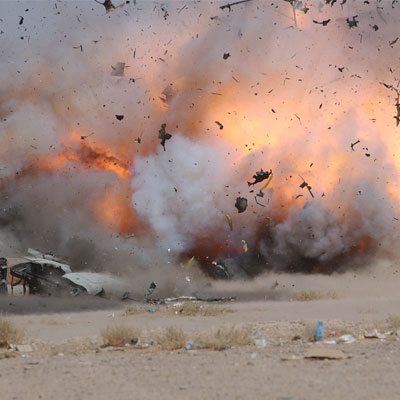Overview
- Start dateSeptember
- DurationMSc: 11 months full-time, up to three years part-time; PgDip: up to 11 months full-time, up to two years part-time; PgCert: up to 11 months full-time, up to two years part-time
- DeliveryCoursework, examination, group project and individual thesis (MSc only)
- QualificationMSc, PgDip, PgCert
- Study typeFull-time / Part-time
- CampusCranfield University at Shrivenham
Who is it for?
This course has been designed specifically to provide an opportunity to a wide range of attendees, including military officers, defence industry staff, government servants and civilian students, to provide knowledge and transferable skills that will enhance employment potential in this field, problem solving, self-direction and informed communication skills.
Students can learn in a flexible manner as the course offers both part-time and full-time learning with full access to an outstanding remote virtual learning environment and online literature through our extensive library facilities.
Why this course?
This course specialises in explosive ordnance and engineering and is world class in teaching and research. We have a diverse student body drawn mainly from personnel linked to the military from numerous industries and institutions in the UK as well as overseas, providing a rich educational experience.
Students are introduced to up-to-date and current research, which enables them to obtain a critical awareness to problem solving and capability to evaluate both military and commercial best practice in the field of EOE.
Some visits are restricted to Five Eyes nations only (i.e. Aus/Can/UK/US/NZ). Please contact us for more information.
Course details
Part one of the MSc course contains an introductory period followed by academic instruction, which is in modular form. Students take four core modules covering the main disciplines and choose a number of elective modules equating to 60 credits based upon their particular background, future requirements or research interests.
Course delivery
Coursework, examination, group project and individual thesis (MSc only)
Group project
To integrate module learning into an overall critical evaluation of new trends in EOE, students undertake a group project, which considers current ‘Hot Topics in EOE’ - for example, nanotechnology, insensitive munitions, analysis and detection and environmental initiatives. The group project involves students working together to research these hot topics and to critically appraise the facts, principles, concepts, and theories relating to a specific area of EOE. They do this as a group and then individually prepare elements of a presentation that they feedback in groups to their peers in an open forum. The presentation is then graded from an individual and group perspective.
The group project enables the students to work as a team, enhances their communication skills and encourages the ability to present scientific ideas in a clear and concise manner. It also gives the students an understanding of the procedures and challenges associated with peer review and grading, and prioritisation of presented work against a clear assessment framework.
Individual project
The aim of the individual project phase is to give students an opportunity to apply the skills, knowledge and understanding acquired on the taught phase of the course to a practical problem in EOE. A list of available project titles is produced in the first few months of the course so that a student can make an early choice and begin planning their programmes well before the project phase begins. Suggestions for projects may come from a variety of sources, for example, an individual student’s sponsor, a member of staff or the wider EOE community.
Modules
Keeping our courses up-to-date and current requires constant innovation and change. The modules we offer reflect the needs of business and industry and the research interests of our staff and, as a result, may change or be withdrawn due to research developments, legislation changes or for a variety of other reasons. Changes may also be designed to improve the student learning experience or to respond to feedback from students, external examiners, accreditation bodies and industrial advisory panels.
To give you a taster, we have listed the compulsory and elective (where applicable) modules which are currently affiliated with this course. All modules are indicative only, and may be subject to change for your year of entry.
Course modules
Compulsory modules
All the modules in the following list need to be taken as part of this course.
Introduction to Explosives Engineering
| Module Leader |
|
|---|---|
| Aim |
To provide a through life perspective of explosives ordnance engineering. |
| Syllabus |
This module will cover: |
| Intended learning outcomes |
On successful completion of this module you will be able to:
|
Research Tools
| Module Leader |
|
|---|---|
| Aim |
|
| Syllabus |
This module will cover: |
| Intended learning outcomes |
On successful completion of the module you will be able to:
|
Munitions and Target Response
| Module Leader |
|
|---|---|
| Aim |
The aim of the module is to provide you with the skills and knowledge to analyse targets and defeat mechanisms. |
| Syllabus |
This module covers:
|
| Intended learning outcomes |
On successful completion of this module you will be able to:
|
Future Developments: Scanning the Horizon in EOE
| Module Leader |
|
|---|---|
| Aim |
To provide a capstone module for the EOE MSc, by integrating the learning from the taught phase with a critical evaluation of new trends and technologies in EOE. |
| Syllabus |
Current ‘Hot Topics in EOE’, including, for example:
|
| Intended learning outcomes |
On successful completion of this module you will be able to:
|
Thesis
| Module Leader |
|
|---|---|
| Aim |
|
| Syllabus |
|
| Intended learning outcomes |
|
Elective modules
A number of the modules from the following list needs to be taken as part of this course.
Introductory Studies
| Module Leader |
|
|---|---|
| Aim |
The aim of Introductory Studies is to prepare students for their subsequent programme of study on the assessed modules. The module is designed to enable students to revise, consolidate and expand their skill and knowledge base so that they can derive maximum benefit from their course of study. It is an optional module and carries a formal credit rating of zero, although a student’s understanding of the materials covered may be tested as part of the assessment for subsequent course modules.
|
| Syllabus |
|
| Intended learning outcomes |
On successful completion of this module a student should be able to:
|
Gun Propellants
| Module Leader |
|
|---|---|
| Aim |
To develop a comprehensive knowledge of gun propellants, including manufacture, properties and ballistics.
|
| Syllabus |
|
| Intended learning outcomes |
On successful completion of the module you will be able to:
|
Testing and Evaluation of Explosives
| Module Leader |
|
|---|---|
| Aim |
|
| Syllabus |
This module will cover: |
| Intended learning outcomes |
On successful completion of the module you will be able to:
|
Rocket Motors and Propellants
| Module Leader |
|
|---|---|
| Aim |
To develop an understanding of the principles of rocket propulsion and of rocket propellant composition and performance. |
| Syllabus |
Rocket Propulsion: Chemistry: |
| Intended learning outcomes |
On successful completion of the module you will be able to:
|
Pyrotechnics
| Module Leader |
|
|---|---|
| Aim |
To provide an understanding of basic pyrotechnic reactions, the concept of required effects, physical properties of pyrotechnic compositions, simple examples and the associated hazards. This leads to more complex applications of pyrotechnics; provide an understanding of how pyrotechnics and pyrotechnic munitions are manufactured and work, advanced electromagnetic effects, current pyrotechnic advances and research, hands on experience of laboratory manufacture and the demonstration of the manufactured devices. |
| Syllabus |
|
| Intended learning outcomes |
On successful completion of the module you will be able to:
|
Explosives and the Environment
| Module Leader |
|
|---|---|
| Aim |
To provide a comprehensive overview of the behaviour of explosives in the environment and their pollutant linkages. |
| Syllabus |
|
| Intended learning outcomes |
On successful completion of this module you will be able to:
|
Maritime Underwater Munitions
| Module Leader |
|
|---|---|
| Aim |
To provide insight into the principles of maritime and underwater warfare. |
| Syllabus |
|
| Intended learning outcomes |
On successful completion of the module you will be able to:
|
Manufacture and Material Properties of Explosives
| Module Leader |
|
|---|---|
| Aim |
To provide a critical understanding of how the manufacturing processes for explosives and their formulations affect the properties and ultimately their performance and safety. |
| Syllabus |
Chemistry of explosive molecules and associated materials: Material science of explosive materials: Engineering of the manufacture of explosives: Manufacturing Health & Safety: |
| Intended learning outcomes |
On successful completion of the module you will be able to:
|
Delivery Systems
| Module Leader |
|
|---|---|
| Aim |
|
| Syllabus |
|
| Intended learning outcomes |
On successful completion of this module you will be able to:
|
Counter Improvised Explosive Devices Capability
| Module Leader |
|
|---|---|
| Aim |
The aim of the C-IED Capability course is to educate industry, military and civilian MoD C-IED and Counter Threat professionals in a system engineering & critical thinking approach to the Counter IED/Threat system. |
| Syllabus |
Subjects covered will include:
|
| Intended learning outcomes |
On successful completion of this module you will be able to:
|
Design for Vulnerability
| Module Leader |
|
|---|---|
| Aim |
Extreme but credible accidents and enemy action (EA)2 can cause munitions to react violently, with potentially severe consequences for people, equipment and infrastructure. Using a common scientific framework and set of evidence, Insensitive Munitions (IM) Policy drives the design of safer munitions; Hazard Classification (HC) controls their storage and transport; and Explosive Risk assessment builds on these to manage residual risks. The aim of the Design for Vulnerability module is to explore the policies and processes used to manage the consequences of such EA2 events throughout the munition lifecycle; the science underpinning the response of energetic materials and weapons systems to these EA2 events; design principles to minimise the responses; and tools and techniques to manage these responses. Taking the IM and HC criteria as a starting point, this module describes the reaction mechanisms that can lead to violent reactions and associated experimental and modelling techniques; and develops the qualities needed for safe design through explosive and propellant formulation; warhead, rocket motor packaging design; together with threat hazard assessment to develop a risk-based approach to accidents or actionEA2, through an holistic approach to munitions safety balancing a sense of the possible against need. |
| Syllabus |
|
| Intended learning outcomes |
On successful completion of this module you will be able to:
|
Safety Assurance in EOE
| Module Leader |
|
|---|---|
| Aim |
|
| Syllabus |
|
| Intended learning outcomes |
On successful completion of this module you will be able to:
|
Addressing EOE Capability Gaps
| Module Leader |
|
|---|---|
| Aim |
To address knowledge gaps in military or industrial EOE capability by working in a team to design and conduct scientifically rigorous analytical procedures and present clear results of a particular EOE project. |
| Syllabus |
This module will cover: |
| Intended learning outcomes |
On successful completion of this module you will be able to:
|
Weapon Life Assessment
| Module Leader |
|
|---|---|
| Aim |
|
| Syllabus |
|
| Intended learning outcomes |
On successful completion of this module you will be able to:
|
Teaching team
You will be taught by Cranfield's leading experts with capability expertise, industry knowledge and collective subject research experience, as well as external speakers from industry and defence. The Course Director is Dr Lisa Humphreys. The co-module leads are listed below:
Accreditation
The MSc of this course meets the educational requirements for the Engineering Council UK register of Chartered Engineers (CEng); the course is accredited by the Institution of Mechanical Engineers (IMechE).
Accredited by the Institution of Engineering and Technology (IET) on behalf of the Engineering Council as meeting the requirements for Further Learning for registration as a Chartered Engineer. Candidates must hold a CEng accredited BEng/BSc (Hons) undergraduate first degree to comply with full CEng registration requirements.
This course is CEng accredited and fulfils the educational requirements for registration as a Chartered Engineer when presented with a CEng accredited bachelor's programme.

Your career
Many of the students are linked to military employment and as such are sponsored through this route. Therefore, the majority of students continue to work for them on completion of the course. However, the course has the potential to take you on to enhanced career opportunities often at a more senior level across a range of roles corresponding with your experience.
Cranfield Careers and Employability Service
Cranfield’s Career Service is dedicated to helping you meet your career aspirations. You will have access to career coaching and advice, CV development, interview practice, access to hundreds of available jobs via our Symplicity platform and opportunities to meet recruiting employers at our careers fairs. Our strong reputation and links with potential employers provide you with outstanding opportunities to secure interesting jobs and develop successful careers. Support continues after graduation and as a Cranfield alumnus, you have free life-long access to a range of career resources to help you continue your education and enhance your career.
How to apply
Click on the ‘Apply Now’ button to start your online application.
See our Application guide for information on our application process and entry requirements.
























